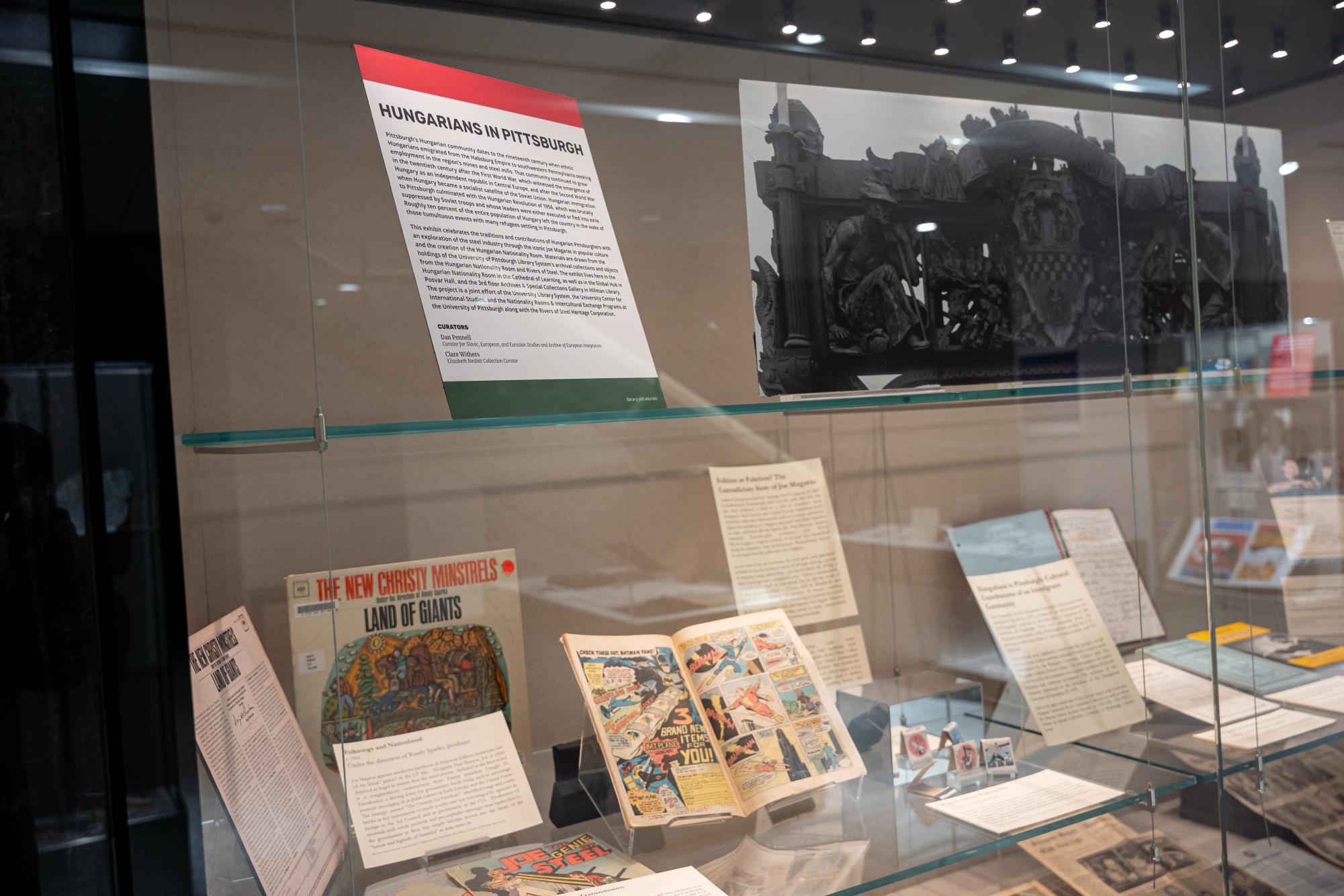Hillman exhibit highlights Hungarian immigrant steelworkers in Pittsburgh


Artifacts sit on display on the third floor of Hillman Library.
Pitt’s Hungarians in Pittsburgh exhibit features the Cathedral of Learning in a comic book from the 1950s, accident report cards from steel mills, safety glasses from the 1920s, archival newspaper articles and other historical artifacts detailing the stories of Hungarian immigrants in the Pittsburgh steel industry.
The new exhibit is located on the third floor of Hillman Library and in the Global Hub in Posvar Hall. The exhibit was a creation of the Pitt Library System’s Archives and Special Collections department. It explores the history of the local steel industry and the legend of Joe Magarac throughout the 20th century. The exhibit provided insight into the creation of the Hungarian Nationality Room in the Cathedral of Learning, unearthed Hungary-related materials in the Pitt Archives and explored the broad history of Pittsburgh’s Hungarian community.
Clare Withers is the co-curator for the exhibit and also serves as Pitt’s liaison librarian for children’s literature, cultural studies and medieval and Renaissance studies. Withers said a Pitt graduate, Danielle Obisie-Orlu, conceived the idea for the exhibit during the spring of 2023, Obisie-Orlu’s final semester.
“She had this idea for doing some kind of an exhibit about Hungarians and Pittsburgh and really she also wanted to look at Joe Magarac, because most of the lore is that he was Hungarian somehow. So that was the nucleus of what started this collaboration and exhibits,” Withers said.
Thousands of immigrants from Central and Eastern Europe, including many Hungarians, flowed into Pittsburgh to work in the prosperous steel industry in Western Pennsylvania throughout the 20th century. Dan Pennell, a co-curator for the exhibit and curator for Pitt’s Slavic, European and Eurasian Studies program, said around 1,000 of the roughly 30,000 Hungarians who moved to the United States after the Hungarian Revolution in 1956 settled in the Pittsburgh area. Hungarian immigrants shaped Pittsburgh’s economic and demographic landscape — over 40,000 people in the Pittsburgh area claim Hungarian heritage today, even after the steel industry has largely declined.
Withers described the inspiration for this exhibit and the significance of the Hungarian-American folkloric figure Joe Magarac for immigrant steelworkers.
“One of the things that is close to my heart is this Pittsburgh tall tale figure that not everybody knows about. People know about Paul Bunyan, but they don’t know about Joe Magarac. He was the man of steel, he was tall as a smokestack,” Withers said.
The apocryphal story of Joe Magarac represented the epitome of a steelworker in Pittsburgh’s mills. The legend of Joe Magarac is interwoven with the history of Pittsburgh immigrant labor, which played a pivotal role in shaping the region.
One notable item in the exhibit is an accident report card used in a Pittsburgh steel mill. Pennell expanded on the report card’s purpose in a hazardous steel working environment.
“These accident report cards, which is a bit of a euphemism because, as our colleague Kirsten Paine from Rivers of Steel pointed out, these accident reports were only ever issued when there was a fatality. So it was only when someone was killed on a job that they bothered filling out, quote, accident report.”
Pennell said many workplace injuries in Pittsburgh steel mills were unaccounted for, demonstrating the harsh working conditions that immigrants faced. He said the report cards joined the collection through a miraculous coincidence.
“What was a tragedy preempted is that Kirsten Paine from Rivers of Steel was approached by someone who found a big bundle of these cards in a dumpster being thrown out, because the offices of whatever steel plant at which they were located was being cleared out for the property to be sold,” Pennell said.
Pennell said researchers can study these cards to piece together a picture of the demographics of Pittsburgh’s steel mills and its Hungarian immigrant community. Taking a closer look reveals patterns in the data.
“What’s interesting, too, is that a closer examination of some of these accident cards allows you to at least begin to get a sense of the ethnic stratification within the mills. The cards show the unit or the division in which the victim died in an accident, since it does indicate their ethnicity,” Pennell said. “A closer examination of these might allow you to start putting patterns together to see how there was ethnic stratification in the middle based on the predominance of a specific nationality.”
Hebah Uddin, a second-year doctorate student studying children’s literature, says the exhibit taught her about all the different ethnic groups that encompassed Pittsburgh’s steel industry.
“It’s really fascinating to know that there was such a big Hungarian subset of steel workers and the amount of culture that is available in the archives,” Uddin said.
Recent Posts
‘He’s off to a much faster and better start’: Republicans reflect the second Trump administration’s first two months
Since Inauguration Day Trump’s second term has caused division amongst young Americans. Despite these controversies,…
Who Asked? // Why do we accept bad treatment from people?
This installment of Who Asked? by staff writer Brynn Murawski attempts to untangle the complicated…
What, Like It’s Hard? // Lean on your people
Contributing editor Livia LaMarca talks about leaning on your support networks and gives advice on…
Note to Self // Hot Girl Summer
In the sixth edition of Note to Self, Morgan Arlia talks about how she is…
A Good Hill to Die On // Down to Date and Time
In the latest version of “A Good Hill to Die On,” staff writer Sierra O’Neil…
‘Dress for Success: Closet to Career’ alleviates the stress of building a professional wardrobe
As the end of the spring semester rapidly approaches, many Pitt students find themselves in…

